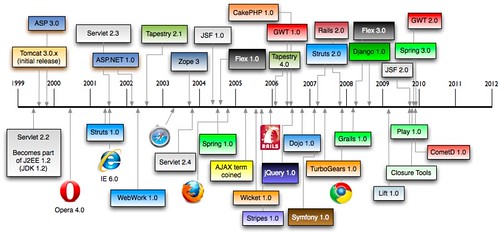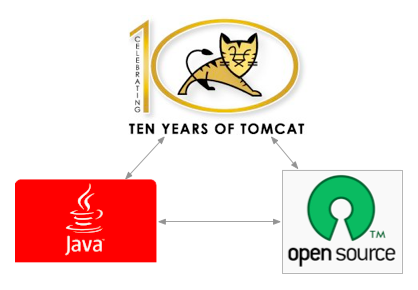What's Happening in the Java World?
This morning at TheServerSide Java Symposium I attended James Gosling's keynote. Below are my notes from his talk.
The unifying principle for Java is the Network - it ties everything together. Enterprise, Desktop, Web, Mobile, HPC, Media and Embedded. The most important thing in the Java world is the acquisition of Sun by Oracle. James is showing a slide of Duke in a fish tank with a "Snorcle!" title above it.
Obligatory statistics for Java:
- 15 million JRE downloads/week (doesn't count tax season in Brazil)
- 10 billion-ish Java enabled devices (more devices than people)
- 1 billion-ish Java enabled desktops
- 100 million-ish TV devices
- 2.6 billion-ish mobile devices
- 5.5 billion-ish smart cards
- 6.5 million professional Java developers
Java has become "Learn Once, Work Anywhere". Most college students worldwide have taken a Java course in school. James' daughter is in college but isn't interested in Java, mostly because her dad's name is all over the textbooks.
Java EE 6 was approved September 30, 2009. It was many years in the making; the result of large-scale community collaboration. It was built by hardware manufacturers, users, developers and academia. Because of all the politics involved, many engineers had to become diplomats. Most software engineers are from the wrong Myers-Brigg quadrant for this type of negotiation. Needless to say, the process was interesting.
New and Updated APIs in Java EE 6: Servlet 3.0, JAX-RS 1.1, Bean Validation 1.0, DI 1.0, CDI 1.0, Managed Beans 1.0, JASPIC 1.1, EJB 3.1, JPA 2.0 and many others. Also new is the Web Profile. It's the first Java EE profile to be defined. It's a fully-functional, mid-size stack for modern web application development. It's complete, but not the kitchen sink. It's what most people use when building a modern web application in Java.
Java EE 6 adds dependency injection with DI (JSR-330) and CDI (JSR-299). @Resource is still around, but an @Inject annotation has been added for typesafe injection. It has automatic scope management (request, session, etc.) and is extensible via a BeanManager API.
GlassFish is the world's most downloaded app server (1 million-ish downloads/month). GFv2 was the EE 5 reference implementation. GFv3 is the reference implementation for EE 6. But it's not just a reference implementation, it's a benchmark-winning mission-critical large-scale app server. The FCS was released on December 10, 2009.
Goals of Java EE: ease of use, right-sizing and extensibility. Now Roberto Chinnici (EE 6 spec lead) and another guy are on stage showing a NetBeans and GlassFish demo. With Servlet 3.0, you don't need a web.xml file, you just need a WEB-INF directory. There's a new @WebServlet annotation that lets you specify a "urlPattern" value for the servlet-mapping. A new @EJB annotation allows you to easily inject EJBs into your servlet. Roberto wired in an EJB, hit Ctrl+S and refreshed his browser and it all worked immediately. In the background, NetBeans and GlassFish did the redeployment and initialized the EJB container in milliseconds.
@ManagedBeans and @SessionScope and @Named are all part of CDI. When using @Named, the beans become available to JSTL and you can access them using ${beanName.property}. Interestingly, the CDI annotations are in difference packages: javax.annotation.ManagedBean and javax.enterprise.context.RequestScoped.
As David Geary mentions, it's great to see the influence that Ruby on Rails has had on Java EE.
Long demo of JEE6 in NetBeans. Spent quite a bit of time extolling the virtues of hot deploy. Thanks, RoR!
Now Roberto is showing us the admin console of GlassFish and how modular it is. He's installing a JMS module, but it's interesting to see that there's a Ruby Container installed by default. Apache Felix is the underlying OSGI implementation used by GlassFish. You can telnet into it and see the status of all the bundles installed. After installing the full-profile, Roberto shows that you can restart the server from the console.
Isn't the whole point of OSGI that you don't have to restart anything!?
The GlassFish management console is definitely impressive and visually appealing. Apparently, it's extensible too, so you could easily write plugins to monitor your application and provide memory statistics.
Changing topics, one of the things that nice about Java is its a two-level spec. The important thing in the Java world isn't the language, it's the virtual machine. The magic is in the VM! Scala, Ruby/Rails, Groovy/Grails, Python, PHP, JavaScript, JavaFX and many others. In the same breath of talking about Java.next languages, James mentioned JavaFX Script. It's a new declarative scripting language for GUIs. It's similar to Flash or Silverlight, but it's much better because it has the Java VM under it.
At the current rate that we're going with CPUs and cores, there's a good chance we'll have 5220 cores on our desktops by 2030. If you find the concurrency libraries scary, get over it.
For the rest of talk, James talked about what he's hacking on these days. He's helping build an Audi TTS for the Pikes Peak Road Rally in Colorado. The goal is to figure out a way to keep the vehicle above 130 MPH for the whole race. Sounds like a pretty cool project to me.
I don't think there was a whole lot of new information covered in James' talk, but I really do like Java EE 6's Web Profile. However, I think it's something most of the community has been using for many years with Tomcat + Spring + Hibernate. Now it's simply been standardized. If you happen to work at one of those companies that frowns on open source and smiles at standards, you've finally caught up with the rest of us. 







